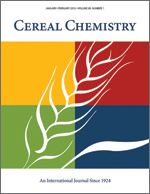
Cereal Chem. 71:594-601 | VIEW
ARTICLE
Formulation of Gluten-Free Pocket-Type Flat Breads: Optimization of Methylcellulose, Gum Arabic, and Egg-Albumen Levels by Response Surface Methodology.
I. Toufeili, S. Dagher, S. Shadarevian, A. Noureddine, M. Sarakbia, and M. T. Farran. Copyright 1994 by the American Association of Cereal Chemists, Inc.
Response surface methodology was used to analyze the effects of methylcellulose, egg albumen, and gum arabic on the sensory properties of gluten-free pocket-type flat bread baked from a formula based on pregelatinized rice flour, corn starch, and corn flour. A rotatable central-composite design consisted of three variables (methylcellulose, egg albumen, and gum arabic) in a five-level pattern (1.37, 2, 3, 4, and 4.63 g) with 20 runs (gluten-free formulations), prepared over three blocks. This design was used to develop models for the different sensory responses. Responses were affected most by changes in methylcellulose and egg albumen levels, and to a lesser extent by gum arabic levels. Individual contour plots of the different responses were superimposed, and regions meeting the maximum number of bread sensory attributes were identified. When 3 g of gum arabic was included in the bake mix, gluten-free breads, comparable with regular wheat bread in the frequency of cracks, separation of layers, rollability, tearing quality, hardness, adhesiveness, and cohesiveness, were obtained at methylcellulose levels greater than or equal to 2.10 g and less than or equal to 4.12 g and at egg albumen levels greater than or equal to 2.18 g and less than or equal to 4.10 g. Higher levels (4.63 g) of gum arabic resulted in more cohesive products. Lower levels (1.37g) of the gum produced loaves that were less cohesive and inferior to wheat bread in rollability. All breads possessed a perceptible corn flavor, a light-yellow crumb with apparent waxy patches, and a faster staling rate than that of regular wheat bread.